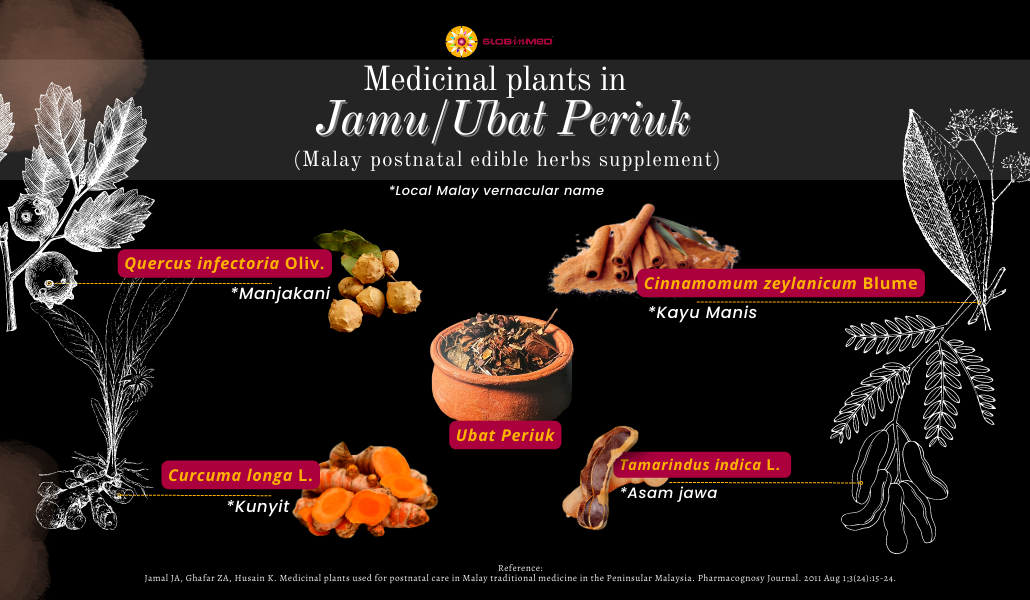Traditional Malay Postnatal Care is a customary practice observed by Malays during confinement period to aid maternal healing and energy replenishment of postpartum women throughout a specific period. The postnatal period begins immediately after the birth of the baby and extends up to six weeks (42 days) after birth [1]. The healing tradition of Malay women could be aided and guided by a Malay midwife. This Malay Midwife is a traditional skilled birth attendant, known locally as Bidan. Bidan is an active supportive role in traditional Malay postnatal care throughout the specified time of confinement which ranges around 44 -100 days.
Malay postnatal care is a shared responsibility concept. Each community member has their own role in enabling a positive postnatal experience. This including partners, family, and elders. Besides Bidan (village midwife), the elders of the mother also behave in a supportive role to instil the positive perception, preparedness, and new mother training session towards a new phase of life.
This postnatal Malay routine could provide confidence to navigate physical and emotional challenges and experience the dynamic achievement of maternal personal growth. The postnatal or post-partum or confinement period observed by the Malay women is usually 44 days or 60 days or 100 days. Special precautions are followed for those women who had undergone Caesarean-section (surgery) birth as compared to those with normal birth.
Postnatal treatment practice during the confinement period usually involves the following:
- Bertungku: Hot press/ Hot compression
- Berbengkung/ Berbarut: Body binding/ Body wrapping/ Traditional girdle/Traditional corset
- Berurut: Post-natal body massage
- Bertangas: Vaginal steam bath
- Tapel, Param, Pilis: Application of herbal paste topically on different body parts
- Jamu/ Ubat Periuk: Traditionally prepared edible supplements using herbs mixture
A postnatal woman also must remain at home and diligently observe her behaviour to a specific diet and daily treatment regime. The regime is believed to promote fast healing of the physical and mental health of the maternal, and also to prevent postpartum depression and anxiety. According to a study conducted in Malaysia in 2021, most of the women used Malay post-natal care to improve their general well-being (72.1%). Half of the women said they took the service to enhance breastfeeding (51.1%) and one-third used it for losing weight (34.9%), 27% used Malay post-natal care due to cultural beliefs, and 24% due to back pain. Some women took Malay postnatal care for sleep problems (6.9%). [2]
6 Main practices in Traditional Malay Postnatal Care
1. Tungku : Hot compression
A hot compress is a form of point massage using heated objects with soft pressure applied to the body. Tungku is a local name for the apparatus used for hot compression. This tungku method is characterized by the gentle press of the heated and wrapped tungku applied topically on the body of the confined mother.
The usual two types of tungku are iron tungku (club-like iron with a handle) or stone tungku (sphere-shaped river stone) as shown in Figure 1 below. These tungku are of varying weights and the weight used would depend on the size of the woman’s body. For overweight woman, a heavier tungku should be used for optimum impact. Tungku is claimed to dissolve residual blood clots in the womb, improve muscle spasms, reduce tummy gas/flatus, improve blood circulation and promote relaxation.
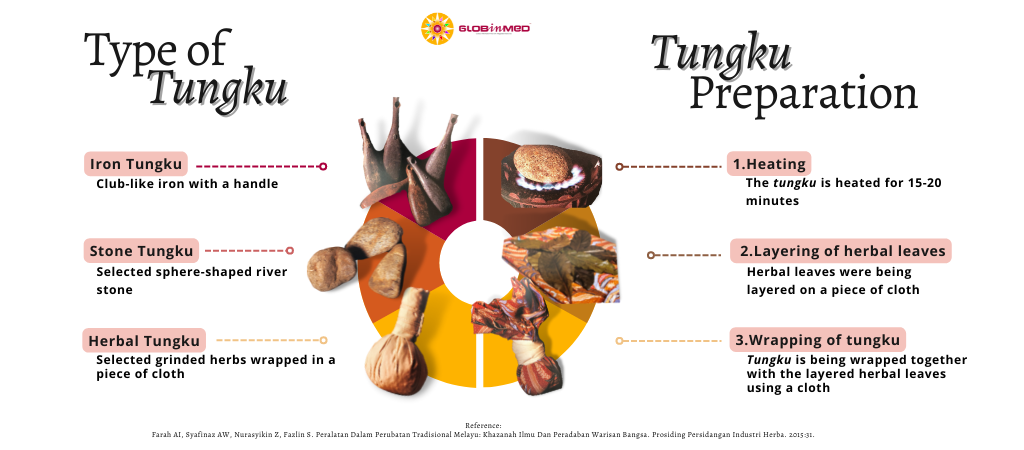
To prepare the hot compress, the tungku is heated up using direct heat such as a stove. Herbal leaves mixture is then placed around the tungku and fabric/cloth (usually kain sarong) is used to wrapped the tungku to reduce direct heat transfer on the maternal body as seen in Figure 1. Herbal used could be taken from leaves of Alpinia galangal (lengkuas) and Morinda citrifolia (mengkudu) and Piper betle L. (sirih) or other herbals with medicinal properties; following herbs’ availability or Bidan’s advice. The application of the tungku topically on the body would include areas such as limbs, shoulders, thighs, hips, abdominal area, tummy, and feet. Traditionally, the hot compress session lasted around half an hour to an hour. [3][4]
2. Berbengkung/Berbarut : Body Wrap/Belly binding/Girdle
Barut or berbengkung is another treatment in postnatal care. Bengkung refers to a special cloth that is tightly wrapped around a confined woman, similar to the concept of body wrap, belly binding or girdle. Traditionally, to wear a bengkung, the process involves applying a herbal paste made from specific herbs and spices onto entire abdomen prior to binding. Tight wrapping or binding is done by using a piece of long cloth (corset-like) covering the abdomen/torso area starting from just beneath the breast to the thighs.
The size of the bengkung would depend on the woman’s body size. The function of this treatment is to restore and deflate the woman’s abdomen after childbirth and to regain the mother’s original body posture and shape. Bengkung must be worn every day throughout the confinement period, therefore allowing the mother to get enough rest considering the bengkung would limit the wearer’s movement and activities. Bengkung unwinding is allowed during a bath or any need for washroom usage.
There are several bengkung used in post-natal treatment depending on the bidan or the mother preferance such as Bengkung Jawa, Bengkung Panjang, Bengkung Roda, Bengkung Tali Kasut or modern bengkung/girdle [5]. The uniqueness of the bengkung could be referred to Figure 2. Some bengkung has left and right strings to be tied together, some use a corset-style cloth with criss-crossed ties and some just need a strap to put in the bengkung. Some would put some ointment on the body (optional to herbal paste) before putting up the bengkung [5].
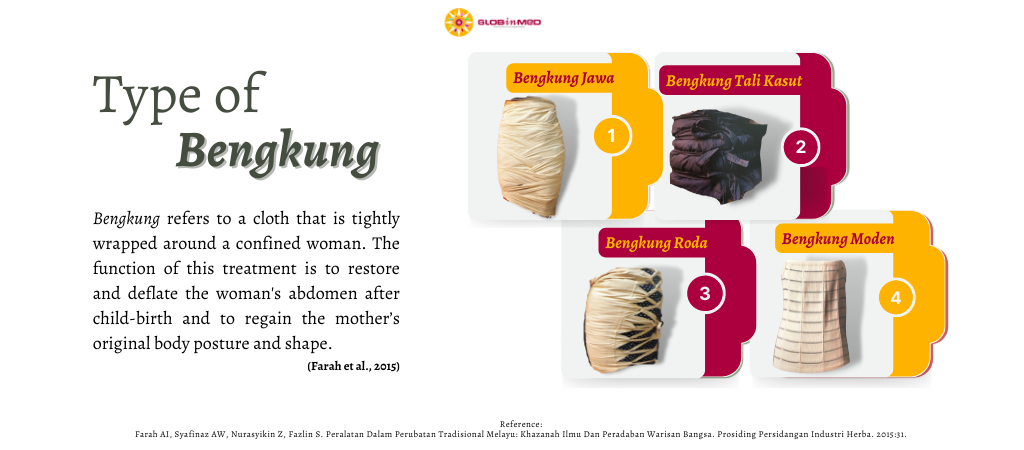
3. Tangas: Vaginal steaming/smoking
Tangas is a traditional postnatal treatment using the heat concept specifically to treat the vagina. This method of vaginal steaming/smoking uses steam/smoke derived from the heated herbal mixture. Tangas treatment is done by sitting on a chair that has an opening in the middle thus exposing the perineum area to steam/smoke produced by the heated Bekas Bertangas (a bucket containing heated herbal mixture) [5]. Please refer to Figure 3 for overall picture of the treatment.
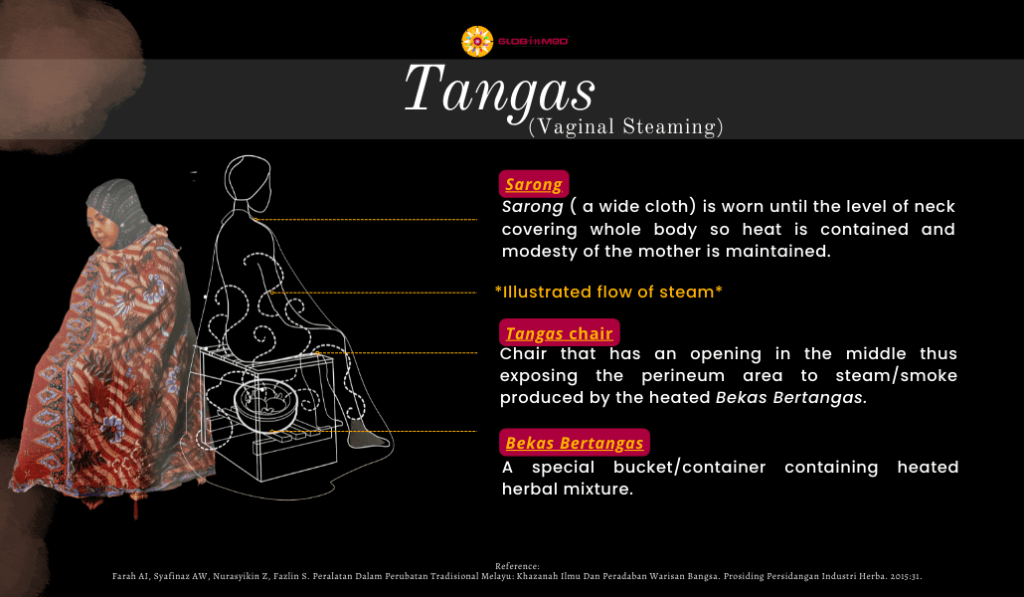
Tangas could be classified into two types; Tangas Kering (vaginal steaming circulation using dry heated air) and Tangas Basah (vaginal steaming circulation using moist/humid heated air). Both are generally using the same method, except for Tangas Basah, the herbal ingredients are boiled first. Tangas is a treatment that aims to stimulate detoxification using sweat, shrink the uterus which has expanded during pregnancy, and recover the birthing route from the vagina to the uterus. [3][6]
4. Berurut: Post-natal body massage
One of the important care regimens during the confinement period is Berurut. Berurut would be categorized into deep tissue massage and therapeutic massage. These will be performed on the confined mother by an experienced Bidan. This Bidan is an experienced masseur, who has full authority on deciding which way to start first, either head or feet or which part of the body needs extra care. The practice is done to improve the mother’s blood circulation, therefore, reducing numbness felt by the mother [7]. The berurut could be done using gestures of kneading, stroking, rubbing or pressing techniques by using the masseur’s hand or an aiding tool [5]. Berurut process is usually aided by massage oil.
Read more on Berurut at : Traditional Malay Massage
5. Param: Application of medicated talcum paste to body parts such as legs and hands.
Param is a medicated talcum paste, made by mixed herbs applied to legs and hands. Typical herbal used are Kaempferia galanga L. (leaf part), Curcuma longa L. (rhizome part), Oryza sativa L. (seed part) and Zingiber officinale Roscoe (rhizome part). The recipe of the grounded plant materials and little water is applied to the body for purpose of warming the body, freshening the body and expelling wind [8]
Pilis: Application of medicated talcum paste onto the forehead.
Pilis is one of the efforts to prevent migraines and dispel wind. Typical herbal used are Nigella sativa L. (seed part), Piper cubeba Bojer (berry part) and Cinnamomum zeylanicum Blume (stem bark part). The recipe of the ground plant materials and water is applied to the forehead (between the eyebrows and below the hairline after bath) to help improve eyesight [8].
Tapel: Application of poultice paste to the abdomen
Tapel’s mixture ingredients were subject to herb’s availability and Bidan’s choice. Typical herbal used are Tamarindus indica L. (fruit part), Zingiber officinale Roscoe (rhizomes part) and Citrus aurantifolia Swingle (fruit part). The applications on the abdomen are believed to provide slimming and encourage contraction of the uterus [8].
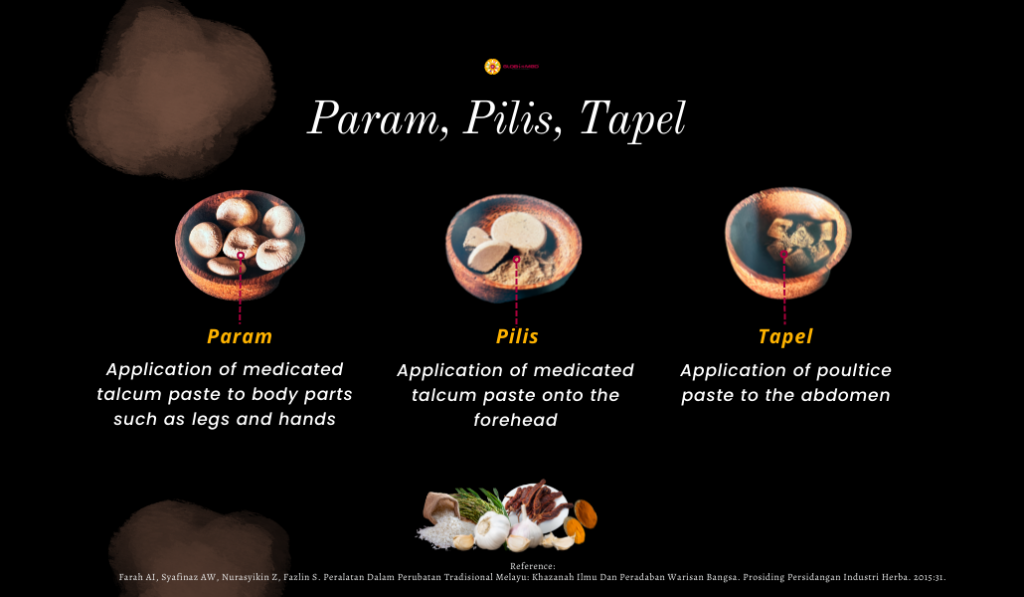
6. Jamu/Ubat Periuk: Edible supplements using herbs mixture
Jamu/ubat periuk is a mixture of various medicinal plants and plant parts, traditionally used in post-partum medication to help improve blood, warming and refreshing of the body, speed up contraction of the uterus and tightening of the vagina, encourage bowel movement and prevent vaginal discharge. [8]
Formulation of jamu/ubat periuk largely relies on the availability of the ingredients. Several local medicinal plants that are used includes rhizomes of Zingiber zerumbet (lempoyang in bahasa)[10], fruit of Coriandrum sativum L. (ketumbar in bahasa), stem bark of Cinnamomum zeylanicum (Kayu manis in bahasa), blume rhizomes of Curcuma longa L. (kunyit in bahasa) and galls of Quercus infectoria Oliv (manjakani in bahasa) [8].
Ways to consume the post-natal herbs mixture are either in the form of ubat periuk or Jamu. Ubat periuk is prepared as a herbal decoction in the form of hot drink, while jamu is available in the form of herbal mixture powder in capsules/ herbal pills [9]
References
[1] World Health Organization. WHO technical consultation on postpartum and postnatal care. World Health Organization; 2010.
[2] Ridzuan MH, Ali MF, Tan CE, Aziz AF. Traditional and Complementary Medicine Use During Postpartum Period: A Cross-Sectional Analysis at a Rural, Public Maternal and Child Health Clinic in West Malaysia. Cureus. 2021 Jun 3;13(6).
[3] Yusoff ZM, Amat A, Naim D, Othman S. Postnatal care practices among the Malays, Chinese and Indians: A comparison. InSHS Web of Conferences 2018 (Vol. 45, p. 05002). EDP Sciences.
[4]Akmal S, Darus M, Bakri R, Jeganathan R. Traditional Postnatal Care in Restoring Women’s Physical and Mental Health. Health Technology Assessment Section (Mahtas) Medical Development Division Ministry Of Health Malaysia Report. 2015(004).
[5] Farah AI, Syafinaz AW, Nurasyikin Z, Fazlin S. Peralatan Dalam Perubatan Tradisional Melayu: Khazanah Ilmu Dan Peradaban Warisan Bangsa. Prosiding Persidangan Industri Herba. 2015:31.
[6] Akhiar SK. Amalan Dan Penggunaan Herba Dalam Perubatan Tradisional Melayu Selepas Bersalin Di Zon Tengah, Semenanjung Malaysia (Doctoral dissertation, Universiti Tun Hussein Onn Malaysia).
[7] Fadzil F, Shamsuddin K, Wan Puteh SE. Traditional postpartum practices among Malaysian mothers: a review. The Journal of Alternative and Complementary Medicine. 2016 Jul 1;22(7):503-8.
[8] Jamal JA, Ghafar ZA, Husain K. Medicinal plants used for postnatal care in Malay traditional medicine in the Peninsular Malaysia. Pharmacognosy Journal. 2011 Aug 1;3(24):15-24.
[9] Ida Farah A, Nur Salsabeela MR, Siti Hajar MR, Noorashikin AH, Nurmaziah MS, Terence TY, SM AF. APPARATUS USED IN MIDWIFERY PRACTISE OF TRADITIONAL MALAY MEDICINE IN PENINSULAR MALAYSIA. Bridging Traditional Knowledge & Natural Products Innovations Towards Wellness and Shared Prosperity.:2
[10] Appalasamy S, Zamri NS, Arumugam N, Nor MM, Zakaria S, Subramaniam S. Conservation of indigenous knowledge on the consumption of medicinal Zingiberaceae by locals in Kelantan, Peninsular Malaysia. InIOP Conference Series: Earth and Environmental Science 2022 Nov 1 (Vol. 1102, No. 1, p. 012064). IOP Publishing.

